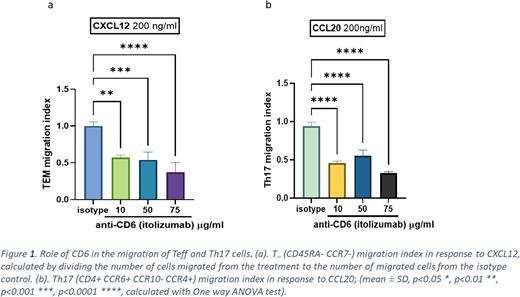Abstract
Introduction:
CD6 is a co-stimulatory T cell receptor involved in T cell activation and trafficking that has been linked to the pathogenesis of multiple inflammatory and autoimmune diseases, including Graft Versus Host Disease (GVHD). Depletion of CD6+ cells prior to allogeneic bone marrow transplantation reduces the incidence of acute GVHD. During inflammation, the ligand of CD6, activated leukocyte cell adhesion molecule (ALCAM), is overexpressed on tissues, potentially enhancing the transmigration of pathogenic T cells, such as Th17 cells, known high expressors of CD6. Chemokines and their receptors play a central role in GVHD, allowing the recruitment of pathogenic cells at the target organs. The chemokine receptor CCR6 is highly expressed on Th17 cells and its interaction with the ligand CCL20 has been shown to be relevant in GVHD, driving the infiltration of alloreactive CD6high CD4+ T cells to the intestine, liver, and skin. Here, we investigate the role of the CD6-ALCAM pathway in the trans endothelial migration of pathogenic Th17 Teff cells.
Methods:
T cell trans endothelial migration was assessed in vitro using a Boyden Chamber assay, in which T cells migrate through a monolayer of HUVECs cells expressing high levels of ALCAM. HUVECs were plated on a PET insert (3mm), that allows the passage of the immune cells, for 48 hours in growth media, allowing the formation of the monolayer. To target CD6 on T cells, we used itolizumab, a first in class anti-CD6 mAb that 1) blocks the CD6-ALCAM binding and 2) induces cleavage of CD6 from the surface of T cells. To target ALCAM, HUVECs were pre-treated for 1hour with an anti-ALCAM mAb. Before entering the migration assay, total PBMCs were rested O/N, pre-activated or not (depending on the donor) with anti-CD3 and anti-CD28 for 2 hours and then pre-treated for 1 hour with different concentrations of itolizumab or the isotype control, generating CD6low and CD6ihgh cells, respectively. Migration of total T cells was induced using the chemokine CXCL12, while CCL20 was used to specifically induce the migration of CCR6+ Th17 effector cells. After the migration, the cells retained in the upper chamber and the cells that migrated to the lower chamber were collected and analyzed by flow cytometry.
Results:
Analysis of migrated T cells showed that blocking ALCAM on the HUVECs using an anti-ALCAM mAb prevents the migration of Teff cells (CD4+ CD45RA- CCR7-) through the endothelial layer in response to the chemokine CXCL12. Interestingly, the cells that migrated in response to CXCL12 expressed higher CD6 levels than the cells retained in the upper chamber. Similar to the ALCAM blocking assay, treatment with itolizumab on total PBMCs prevented the CXCL12-induced migration of pathogenic Teff cells (Fig. 1a), which correlated with the CD6 levels on those cells (R2 ~0.7). Further analysis of the Teff cell populations showed that the migration of the CD6high Th17 population is dependent on CD6, and it is inhibited by itolizumab in a dose-dependent manner.
To further assess the role of CD6 on the migration of Th17 cells, we used CCL20, which induced a dose-dependent migration of Teff cells and of Th17 cells. The introduction of itolizumab reduced CD6 levels and prevented the migration of T cells in response to CCL20 by more than 50%, suggesting that CD6 plays a significant role in the trans-endothelial migration of CCR6+ Effector cells (fig.1b).
Conclusions:
These data demonstrate that the CD6-ALCAM pathway is of key importance for the migration of pathogenic T cells through the endothelial layer. Consequently, blockade of this axis will inhibit the infiltration of those cells into inflamed organs and help restoring the immune balance.
Disclosures
Marrocco:equillium bio: Current Employment, Current equity holder in publicly-traded company. Ampudia:Equillium: Current Employment, Current equity holder in publicly-traded company. Ng:Equillium: Current Employment, Current equity holder in publicly-traded company. Connelly:Equillium: Current Employment, Current equity holder in publicly-traded company, Membership on an entity's Board of Directors or advisory committees.
Author notes
Asterisk with author names denotes non-ASH members.


This feature is available to Subscribers Only
Sign In or Create an Account Close Modal